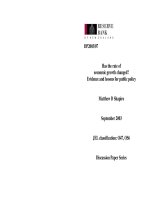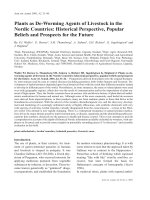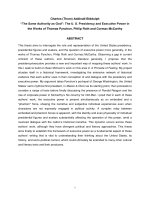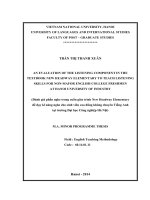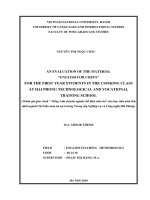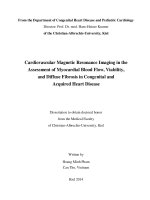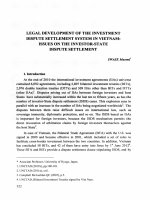THIRD PARTY IN THE WTO DISPUTE SETTLEMENT SYSTEM INTERNATIONAL EXPERIENCES AND LESSONS FOR VIETNAM
Bạn đang xem bản rút gọn của tài liệu. Xem và tải ngay bản đầy đủ của tài liệu tại đây (1.31 MB, 104 trang )
MIMISTRY OF EDUCATION AND TRAINING
FOREIGN TRADE UNIVERSITY
MASTER THESIS
THIRD PARTY IN THE WTO DISPUTE
SETTLEMENT SYSTEM: INTERNATIONAL
EXPERIENCES AND LESSONS FOR VIETNAM
Specialization: The master of International Trade Policy and
Law
NGUYEN THI NGOC HA
Ha Noi - 2019
MIMISTRY OF EDUCATION AND TRAINING
FOREIGN TRADE UNIVERSITY
MASTER THESIS
THIRD PARTY IN THE WTO DISPUTE
SETTLEMENT SYSTEM: INTERNATIONAL
EXPERIENCES AND LESSONS FOR VIETNAM
Major: International economics
Specialization: The master of International Trade Policy and Law
Code: 8310106
Full name
: Nguyen Thi Ngoc Ha
Supervisor
: Dr. Nguyen Ngoc Ha
Ha Noi - 2019
i
ACKNOWLEDGEMENT
I’d like to thank Dr. Nguyen Ngoc Ha, my supervisor during the research period,
for his patient guidance and support. I admire not only his academic knowledge but
also his personal qualities.
I would also like to thank my teacher Ms. Nguyen Hong Vinh and the Faculty
of University – Foreign Trade University, for giving me the opportunity to carry on
my advanced studies and for their ultimate support.
I would like to thank everyone in the class MITPL5 for their support in the
course of the program.
Finally, I would like to thank all my family members, friends and colleagues
who have given me valuable support during my studies.
This thesis studies on the third party in the WTO dispute system is not new but
a very complicated issues required various knowledge, skills and practical
experiences. Thus, the thesis has the inevitable shortcomings and limitations. I look
forward to receiving valuable comments for improving the thesis.
Sincerely,
Hanoi, 2019
The Author
Nguyen Thi Ngoc Ha
ii
CERTIFICATION
I hereby certify that the thesis with the title: “Third party in the WTO Dispute
Settlement System: International Experiences and Lessons for Vietnam” is my own
research and does not reproduce any other materials. The data indicated in the thesis
is clear, accurate and are collected from the confident sources of information.
The Author
Nguyen Thi Ngoc Ha
iii
TABLE OF CONTENT
ACKNOWLEDGEMENT ........................................................................................ i
TABLE OF ABBREVIATIONS ..............................................................................v
LIST OF CHART/ TABLE .................................................................................... vi
INTRODUCTION .....................................................................................................1
CHAPTER 1: THIRD PARTY INTERVENTION IN THE WTO DISPUTE
SETTLEMENT SYSTEM ........................................................................................5
1.1. Overview of the WTO dispute settlement system of WTO ........................5
1.1.1. History of the establishment and development of the WTO dispute
settlement system .................................................................................................5
1.1.2. Principles of WTO dispute settlement system. .........................................8
1.1.3. Dispute settlement Bodies .......................................................................11
1.1.4. Dispute settlement process. .....................................................................16
1.2. WTO rules on third party intervention ......................................................25
1.2.1. Identification ...........................................................................................25
1.2.2. Conditions for becoming a third party ...................................................26
1.2.3. The third party status in each stage of dispute settlement. ...................26
1.2.4 The role of third party intervention .........................................................30
CHAPTER 2: PRACTICES INVOLVED IN DISPUTE SETTLEMENT AS
THIRD PARTY OF SOME WTO MEMBERS ...................................................32
2.1. The developed country members ................................................................35
2.1.1. Japan .......................................................................................................36
2.1.2. The United States of America. ................................................................39
2.2 The developing countries members .............................................................43
2.2.1 China ........................................................................................................46
2.2.2. India.........................................................................................................52
2.2.3. Thailand ..................................................................................................54
2.3. General evaluation and lessons for Vietnam .............................................55
2.3.1 General evaluation ...................................................................................55
2.3.2. Lessons for Vietnam ...............................................................................57
iv
CHAPTER 3: PRACTICES OF VIETNAM INTERVENTION AS THIRD
PARTY
IN
THE
WTO
DISPUTE
SETTLEMENT
SYSTEM
AND
RECOMMENDATIONS. .......................................................................................59
3.1. Practices of Vietnam’s intervention as third party. ..................................59
3.1.1 Classification ............................................................................................59
3.1.3. Legal basis and mechanisms of participation in Vietnam ....................65
3.2. General evaluation and some orientation for Vietnam.............................72
3.2.1. Evaluation of achieved results ...............................................................72
3.2.2 Some orientation for Vietnam .................................................................75
3.3. Recommendations.........................................................................................79
3.3.1. For the Government................................................................................79
3.3.2. To enterprises ..........................................................................................85
CONCLUSION ........................................................................................................88
REFERENCES ........................................................................................................90
APPENDIX ..............................................................................................................93
v
TABLE OF ABBREVIATIONS
1
AB
Appellate Body
2
ACWL Advisory Centre for WTO Law
3
AD
Anti- Dumping
4
DSB
Dispute Settlement Body
5
DSM
Dispute Settlement Mechanism
6
DSS
Dispute Settlement System
7
DSU
Dispute Settlement Understanding
8
EU
European Union
9
GATT
General Agreement on Tariffs and Trade
10 MFN
Most Favoured Nation
11 SCM
Subsidies and Countervailing Measures
12 SG
Safeguard
13 SPS
Snaitary and Phytosanitary Measures
14 TRIMs Trade-Related Investment Measures
15 TRIPs
Trade-Related to Aspects of Interllectual Property Rights
16 US
United State
17 WTO
World Trade Organization
vi
LIST OF CHART/ TABLE
Chart 1.1: WTO Dispute Settlement Process ............................................................15
Chart 2.1: WTO members most involved in disputes, 1995 to 2017 ........................32
Chart 3.1: Participate as a third party of Vietnam.....................................................60
Table 2.1: Top countries access WTO DSS as third party........................................33
Table 2.2: World’s export countries in 2017..................................................................33
Table 2.3: World’s import countries 2017 ................................................................33
Table 2.4: Participate as a third party of developed members. .................................36
Table 2.5: Participate as a third party of developing members. ................................46
vii
ABSTRACT
The thesis provides a theoretical overview of third party invention in the WTO
Dispute Settlement System. We’ll have the knowledge about WTO Dispute
Settlement System, identification of third party and the rights and role of the third
parties in a dispute case.
The thesis also carefully studies the practices of some WTO member both
developed and developing countries (Japan, the USA, China, India, and Thailand)
that frequently involved in WTO Dispute Settlement System as a third party. The
studies show the root reason, the benefit which these members get when they
participate as a third party and the way they organize the related resources and
building regulation and law.
The thesis analyzes the practice of Vietnam intervention as a third party in the WTO
Settlement System, its achieved results and restrictions until now. From these
characteristics of Vietnam and international experiences gives the orientations and
proposes some recommendations to improve Vietnam’s participation in the WTO
Dispute Settlement System.
1
INTRODUCTION
1. Research rationale
Every economy that wants to grow and develop must participate in international
trade activities, participate in the international economy. Thanks to bilateral and
multilateral economic agreements, the international economy is increasingly
developing and closely linked to benefits. In which, there are over 95% of world trade
activities currently governed by the World Trade Organization’s (WTO) Agreements1.
This international organization was established and operated since January 1st, 1995
with the goal of establishing and managing a free and transparent global trade.
This organization inherits, develops the rules, and practices implementing the
General Agreement on Trade and Tariffs - GATT 1947 (limited to trade in goods
only) and is a direct result of the Uruguay Round (covering the areas of trade in goods,
services, intellectual property and investment. As of March, 2019, this organization
has 164 members. Through agreements, countries have an opportunity to cooperate
not only in trade but also in some social fields.
However, deeper participation in the world economy will breed conflicts of
interest among member countries. These conflicts sometimes become cornerstones
that prevent trade flows between nations. To ensure the full and serious
implementation of the provisions of the Agreement, prevent trade measures that
violate the Agreements, contribute to the implementation of the WTO's great
objectives, a disputes settlement system within this organization have been
established. This mechanism is the realization of the trend of legalizing the process
of settling international trade disputes today, gradually replacing the methods of
resolving political and diplomatic disputes in this area. WTO has one of the most
active international dispute settlement system in the world. Since 1995, over 500
disputes have been brought to WTO and over 350 rulings have been issued2.
Ian F. Fergusson, “The World Trade Organization: Background and Issues”, CRS Report for Congress,
Updated May 9, 2007, available at: />(consulted on 12 December 2018).
2
(consulted on 15 February 2018).
1
2
As a member of WTO, Vietnam can use this mechanism for settling possible
trade disputes with other WTO members. The consideration of this dispute settlement
mechanism and its massive case system are of great practical significance not only in
understanding the provisions of the WTO Agreements, but also in protecting them.
However, the participation as a plaintiff or a defendant often requires high manpower,
experiences and skills as well as financial resources. Then, participation as a third
party constitutes a very interesting option, because it will be an opportunity to not
only reinforce the Members’ presence in the DSS, but also to allow them to learn and
accumulate experience when the WTO dispute settlement process is becoming more
and more technical. In the practice, some WTO’s Members, as the United States, the
European Union, Japan, China and other developing Members have profited from its
participation as third party in DSS. From this point of view, Vietnam could use third
party intervention as a legal instrument for reinforce its participation in the DSS.
Nonetheless, for more than 10 years of participating in DSS, Vietnam did not consider
third party intervention as a useful tool, especially in order to strengthen its capacities.
Therefore, what are WTO’s rules governing third party intervention in DSS? What is
the role of third party and third party intervention in this mechanism? How are
international experiences on this issue? How can Vietnam use these international
experiences to gain practical benefits to reinforce its role in DSS? To answer these
questions, I have chosen the topic “Third party in the WTO Dispute Settlement
System: International Experiences and Lessons for Vietnam” as my graduation
thesis topic.
2. Literature review
Given the practical benefits, WTO members actively involve in dispute
settlement system at the WTO as a third party. Vietnam is also aware of this issue
and is actively participating in this capacity in the DSU dispute settlement cases.
Since the date of accession (January 11th, 2007), Vietnam has so far participated in
38 cases, in 5 of which cases stood as plaintiffs and participated as a third party in 33
cases. However, in terms of theoretical basis and research projects of scale and overall,
this regulation in Vietnam has not been properly concerned.
3
In the curricula of law schools and economics of our country, the law has not
mentioned the system of participating in the settlement of trade disputes of WTO as
a third party both in terms of theory and Practice. Also, in scientific works in
specialized journals such as Journal of Law, Law and State Magazine ... mentioned
the above issue, however, these studies only study participation. The WTO's general
dispute settlement system has not studied in depth the WTO dispute settlement
system as a third party. Some monographs, documents, articles related to WTO and
dispute settlement system of WTO can be mentioned as:
Participating in trade dispute settlement mechanism as a third party (Vu Quoc
Khanh, Faculty of Law - Hanoi National University 2012); China participates as a
third party into the World Trade Organization's dispute settlement mechanism and
experiences for Vietnam (Dr. Nguyen Ngoc Ha - Law and State magazine No11 (343),
2016). Foreign experience and strengthening Vietnam's participation in dispute
settlement mechanism at the World Trade Organization (WTO) (VNU Journal of
Science - Law No. 28, pages 165–181) and “Some issues from a procedural
perspective in Vietnam's first lawsuit at WTO” (Journal of Legislative Studies No.
16, pages 19–29); Acessing the WTO Settlement System as a third party (website:
– 24/9/2014); Improving the effectiveness of Vietnam's
participation in the WTO dispute settlement mechanism ( 10/3/2015)…
3. Objectives of the research
The thesis focuses on studying the issue of joining WTO's dispute settlement
system (hereinafter referred to as DSU) as a third party with the aim of determining
the legal basis and experiences from the praticial particiapation as third party of some
members, thereby drawing lessons for Vietnam. This research also focuses on
analyzing the practice of Vietnam’s participation in WTO’s DSS as third party, and
on proposing for Vietnam some recommendations in order to improve its
participation in this system in the upcoming dispute resolution cases of WTO.
4. Scope of the research
4
In the context of international economic integration today, the issue of resolving
trade disputes arising between countries has always been recognized as complex and
diverse. On the other hand, with the development of current international relations,
the practice of resolving disputes in international organizations in general and WTO
in particular has been posing many issues that need to be addressed research center.
The thesis does not address all the issues, but focuses on the following contents:
Theoretical issues of participating in the WTO trade dispute settlement system as a
third party; the practice of participating in the WTO dispute settlement system as a
third party of some WTO’s Members and Vietnam; recommendations for Vietnam to
improve its participation in the WTO's dispute settlement system as a third party.
5. Methodology
The topic is studied on dialectical materialist perspective, combined with
methods of statistical analysis, synthesis methods, comparisons, historical methods
and developmental methods.
The thesis is also carried out from the point of view of the State of the Socialist
Republic of Vietnam through guidelines and policies on economic integration and
development in the new era.
The thesis is presented by the method of analysis, interpretation and inductive
combined with comparative and statistical methods.
6. Outline of the thesis.
In addition to the introduction and conclusion and lists of references,
abbreviations ... the thesis is divided into three chapters as follows:
Chapter 1: Third party intervention in the WTO Dispute Settlement System
Chapter 2: Practices involved in dispute settlement as a third party of some
WTO Members
Chapter 3: Practices of Vietnam intervention as third party in the WTO Dispute
Settlement System and recommendations
5
CHAPTER 1: THIRD PARTY INTERVENTION IN THE WTO DISPUTE
SETTLEMENT SYSTEM
1.1. Overview of the WTO dispute settlement system of WTO
1.1.1. History of the establishment and development of the WTO dispute
settlement system
World Trade Organization (WTO) came into existence since the 1st of January
1995. It was the result of the Uruguay Round (1986-1995) with the precursor to the
General Agreement on Tariffs and Trade (GATT 1947). According to calculations,
there are over 95% of commercial activities in the world today are governed by the
Agreement of this Organization3.
1.1.1.1. Dispute settlement mechanism of GATT 1947
The dispute settlement mechanism of GATT 1947 was built on the basis of
Article XXII and Article XXIII of the GATT Agreement. Article XXII provides for
consultations procedures between the signatories regarding the application and
implementation of GATT. Article XXIII provides for the conciliation procedure
between dispute parties in the case of a nullification of commercial rights or
impairment due to the acts of a contracting party other. The GATT 1947 Agreement
stipulates that the body competent to settle disputes is the GATT General Assembly.
In fact, most of the dispute resolution was entrusted to the working groups and from
1952 to expert groups by the GATT General Assembly GATT's dispute settlement
mechanism is more “reconciled” than “litigated”, which aims to make the parties of
dispute better understand each other to come up with a solution that is acceptable to
both sides.
The reconciliation task was assigned to the expert team, consisting of 03 or 05
members who were often selected among diplomats working at a delegation in
Ian F. Fergusson, “The World Trade Organization: Background and Issues”, CRS Report for Congress,
Updated May 9, 2007, available at: />(consulted on 12 December 2018). &
3
(consulted on 15 January 2019).
6
Geneva or government officials of third countries who have experienced years on
GATT’s issues.
The expert team is responsible for objectively reviewing the content of the
dispute, any violation of the agreement and any possible damages to a party of dispute
and will prepare a report to submit to the GATT General council to consider. The
approval of report is based on the principle of positive consensus. Positive consensus
meant that there had to be no objection from any contracting party to the decision.
However, this principle made it difficult for the GATT dispute settlement mechanism
because, in theory, any signatory could oppose or delay the establishment of expert
groups and blockade through reports.
One might think that such a system could not possibly have worked. Why would
a respondent not use its right to block the establishment of a panel if it thought that it
might lose the case? Why would the losing party not block the adoption of the panel
report? How could a party refrain from using its veto against the authorization of
countermeasures, from which it would suffer economically? If domestic judicial
systems were to operate on the basis of such a consensus rule, they would probably
fail in most instances. The delay in resolving disputes in many cases has not resulted
in a practical effect for the prevailing party because the damaged product or industry
has lost competitiveness after a period of dispute resolution prolonged.
Certainly, there were a significant number of disputes that were never brought
before the GATT because the complainant suspected that the respondent would
exercise its veto. Thus, the risk of a veto also weakened the GATT dispute settlement
system. In addition, such vetoes actually occurred, especially in economically
important or politically sensitive areas such as anti-dumping. Finally, there was a
deterioration of the system in the 1980s as contracting parties increasingly blocked
the establishment of panels and the adoption of panel reports.
In addition, the adoption of a number of Codes of the 1979 Tokyo round with
separate dispute settlement mechanisms (government procurement, civil aviation ...)
has affected uniformity and weakening the general dispute settlement mechanism of
7
GATT. Some new disputes arise as disputes over trade measures related to investment,
on protection of intellectual property rights, on trade in services ... are not under the
jurisdiction of GATT 1947 and resolution of such disputes outside the multilateral
trading system has sometimes led to unilateral sanctions for developing countries.
1.1.1.2. WTO dispute settlement mechanism
As the inherent problems in the GATT dispute settlement system led to
increasing problems in the 1980s, many contracting parties to GATT 1947, both
developing and developed countries, felt that the system needed improving and
strengthening. Negotiations on dispute settlement were accordingly included and
given high priority on the agenda of the Uruguay Round negotiations. The WTO
dispute settlement mechanism is an inheritance of the rules for dispute settlement that
have promoted positive effects for nearly 50 years in GATT 1947 history. Learning
from the shortcomings in the old mechanism, some fundamental improvements have
been included in the new mechanism, contributing significantly to improve the trial
nature of this procedure as well as strengthening the binding of dispute resolution
decisions.
The WTO's dispute settlement mechanism is built on four principles: they are
basically fair, fast, effective and acceptable to the parties of dispute, consistent with
the goal of preserving the rights and obligations, in accordance with the relevant trade
agreements on the basis of compliance with the rules of international customary law
on interpretation of international treaties.
Arguably, the most important innovation is that the DSU eliminated the right of
individual parties, typically the one whose measure is being challenged, to block the
establishment of panels or the adoption of a report. Now, the DSB automatically
establishes panels and adopts panel and Appellate Body reports unless there is a
consensus not to do so. This “negative” consensus rule contrasts sharply with the
practice under the GATT 1947 and also applies, in addition to the establishment of
panels and the adoption of panel and Appellate Body reports, to the authorization of
countermeasures against a party which fails to implement a ruling.
8
Other important new features of the (WTO) dispute settlement system are the
appellate review of panel reports and a formal surveillance of implementation
following the adoption of panel (and Appellate Body) reports.
The WTO dispute settlement mechanism is now seen as the most effective
dispute settlement mechanism in the international legal system. This mechanism not
only serves as a judicial body but also as a mechanism to prevent disputes, help
balancing the rights and obligations of WTO members. It performs three main
functions: (i) ensure that the multilateral trading system operates safely and
predictably by strengthening and enforcing the mandatory enforcement of the law
(rule of law); (ii) ensure the rights and obligations of WTO members; (iii) clarify
these rights and obligations through the interpretation of the WTO Agreement in
accordance with customary rules of international legal interpretation.
With these functions, the claimants are required to comply with their
commitments under the relevant agreements. The recommendations and rulings of
the Dispute Settlement Body are enforceable to the parties in the dispute.
1.1.2. Principles of WTO dispute settlement system.
In the process of settling disputes between WTO members, these disputes are
resolved on the basis of WTO rules comply with the following specific principles:
1.1.2.1. Prompt settlement of disputes
The DSU emphasizes that prompt settlement of disputes is essential if the
(WTO) is to function effectively and the balance of rights and obligations between
the Members is to be maintained (Article 3.3 of the DSU). It is well known that, to be
achieved, justice must not only provide an equitable outcome but also be swift.
Accordingly, the DSU sets out in considerable detail the procedures and
corresponding deadlines to be followed in resolving disputes. The detailed procedures
are designed to achieve efficiency, including the right of a complainant to move
forward with a complaint even in the absence of agreement by the respondent
(Articles 4.3 and 6.1 of the DSU). If a case is adjudicated, it should normally take no
more than one year for a panel ruling and no more than 16 months if the case is
9
appealed (Article 20 of the DSU). If the complainant deems the case urgent,
consideration of the case should take even less time (Articles 4.9 and 12.8 of the DSU).
The essential issue for effective implementation of WTO functions and
maintaining the appropriate balance between the rights and obligations of members
is the quick resolution of disputes (Article 3.3 of the DSU). Therefore, once the direct
or indirect benefit of the member in accordance with the relevant Agreement is
violated, it must be protected quickly.
1.1.2.2. Principles of efficiency
The effectiveness of WTO dispute settlement systems is ability to provide easy
access to all member states, to resolve disputes in a relatively short time, and to ensure
that rulings are complied with within a reasonable period of time.
In order to protect the rights of the disputing parties, the members expressed
their determination to enhance the effectiveness of the dispute resolution. This is
affirmed in Article 4.1 of the DSU "Members affirmed their determination to enhance
and improve the effectiveness of consultations used by Members", in order to be
effective specified in the consultation period, a first procedure in the dispute
resolution process. In addition, during the entire process of the WTO dispute
settlement process, the parties to the dispute favored a negotiated solution that could
be acceptable to the parties Article 3.7 of the DSU).
1.1.2.3. Confidentiality
This principle in the WTO dispute settlement mechanism is embodied in
conducting consultations and organizing the Panel meetings as well as the
proceedings of the appellate hearing process. Accordingly to this principle, the
consultation process must be kept confidential (Article 4.6 of the DSU: "The
consultation process must be kept confidential, and must not prejudice the rights of
any Member in any process."), meetings of the Panel must be conducted in a nonpublic manner whereby the disputing parties and interested parties may only attend
when invited by the Panel (Point 2, Annex) Table 3 of the DSU on working
procedures: “The panel must be closed. The parties to the dispute, and interested
10
parties, must be present at meetings only when invited by the Panel”. The proceedings
of the Appellate Body (AB) must be kept confidential (Article 17.10 of the DSU: "The
Appellate Body's proceedings must be kept confidential. Newspapers The Appellate
Body's report must be drafted without the participation of the parties to the dispute
and in the spirit of the information provided and the opinions raised ").
1.1.2.4. Mutual acceptance
Although the dispute settlement system is intended to uphold the rights of
aggrieved Members and to clarify the scope of the rights and obligations, which
gradually achieves higher levels of security and predictability, the primary objective
of the system is not to make rulings or to develop jurisprudence. Rather, like other
judicial systems, the priority is to settle disputes, preferably through a mutually
agreed solution that is consistent with the WTO Agreement (Article 3.7 of the DSU).
Adjudication is to be used only when the parties cannot work out a mutually agreed
solution. By requiring formal consultations as the first stage of any dispute, the DSU
provides a framework in which the parties to a dispute must always at least attempt
to negotiate a settlement. Even when the case has progressed to the stage of
adjudication, a bilateral settlement always remains possible, and the parties are
always encouraged to make efforts in that direction (Articles 3.7 and 11 of the DSU).
WTO Members have agreed to use the multilateral system for settling their WTO
trade disputes rather than resorting to unilateral action (Article 23 of the DSU). That
means abiding by the agreed procedures and respecting the rulings once they are
issued and not taking the law into their own hands.
1.1.2.5. Negative consensus principle
The principle of veto consensus (also known as the reverse consensus principle)
is expressed in Article 6.1, Article 16.4 and Article 17.14 of the DSU. In accordance
with this principle, the decision of the DSB, the establishment of a Panel, the report
of the Panel, the Appellate Body's report will not be passed unless all members The
DSB agreed to not approve.
11
In practice this rule allows the report to be adopted quasi-automatically. After
the establishment of a panel the adoption of a panel report by the DSB is the second
key instance in which the decision-making rule of negative consensus applies in the
WTO dispute settlement system. The quasi-automatic adoption of a panel report
pursuant to the negative consensus rule is important because the panel's report only
becomes binding after the DSB has adopted it.
1.1.2.6
Although this is not a principle recognized in the DSU, it is acknowledged from
AB's dispute settlement practice.
The outcome of the resolution process is the decision and recommendation of
the Dispute Settlement Body (DSB). Under the provisions of the DSU, rulings and
recommendations should not increase or decrease the rights and obligations of the
parties stipulated in the relevant agreements (Article 3.2 of the DSU)4 . At the same
time, decisions on dispute settlement are not eliminated or reduced the benefits that
any WTO member has the provisions of the relevant agreements (Article 3.5 of the
DSU)5.
1.1.3. Dispute settlement Bodies
The dispute settlement procedure in the WTO is carried out by different bodies,
each with its own function, creating independence in the investigation activity and
adopting decisions in this mechanism.
1.1.3.1. Dispute Settlement Body (DSB)
According to article IV.3 of the WTO Agreement, “The General Council shall
convene as appropriate to discharge the responsibilities of the Dispute Settlement
“2.The dispute settlement system of the WTO is a central element in providing security and predictability to
the multilateral trading system. The Members recognize that it serves to preserve the rights and obligations
of Members under the covered agreements, and to clarify the existing provisions of those agreements in
accordance with customary rules of interpretation of public international law. Recommendations and rulings
of the DSB cannot add to or diminish the rights and obligations provided in the covered agreements”.
5
“5. All solutions to matters formally raised under the consultation and dispute settlement provisions of the
covered agreements, including arbitration awards, shall be consistent with those agreements and shall not
nullify or impair benefits accruing to any Member under those agreements, nor impede the attainment of any
objective of those agreements”.
4
12
Body provided for in the Dispute Settlement Understanding. The Dispute Settlement
Body may have its own chairman and shall establish such rules of procedure as it
deems necessary for the fulfilment of those responsibilities”.
The DSB is responsible for administering the DSU, i.e. for overseeing the entire
dispute settlement process. The DSB has the authority to establish panels, adopt panel
and Appellate Body reports, maintain surveillance of implementation of rulings and
recommendations and authorize the suspension of obligations under the covered
agreements (Article 2.1 of the DSU). A later chapter on the stages of the dispute
settlement procedure will explain exactly what all these actions mean. In less
technical terms, the DSB is responsible for the referral of a dispute to adjudication
(establishing a panel); for making the adjudicative decision binding (adopting the
reports); generally, for supervising the implementation of the ruling; and for
authorizing “retaliation” when a Member does not comply with the ruling.
The general rule is for the DSB to take decisions by consensus (Article 2.4 of
the DSU). Footnote 1 to Article 2.46 of the DSU defines consensus as being achieved
if no WTO Member, present at the meeting when the decision is taken, formally
objects to the proposed decision. This means that the DSB's decisions are almost
automatically passed because it is difficult to imagine a decision that can be objected
by all DSB members.
The DSB has its own chairperson, who is usually one of the Geneva-based
ambassadors, i.e. a chief of mission of a Member’s permanent representation to the
WTO (Article IV: 3 of the WTO Agreement). The chairperson is appointed by a
consensus decision of the WTO Members. The chairperson of the DSB has mainly
procedural functions, that is, passing information to the Members, chairing the
meeting, calling up and introducing the items on the agenda, giving the floor to
delegations wishing to speak, proposing and, if taken, announcing the requested
“1. DSB shall be deemed to have decided by consensus on a matter submitted for its consideration, if no
Member, present at the meeting of the DSB when the decision is taken, formally objects to the proposed
decision”.
6
13
decision. The chairperson of the DSB is also the addressee of the Members’
communications to the DSB.
1.1.3.2. Panels
Panels are the bodies in charge of adjudicating disputes between Members in
the first instance. The panel consists of 3-5 experts selected on an ad hoc basis who
are responsible for considering a specific issue that is disputed on the basis of WTO
rules cited by the plaintiff. This means that there is no permanent panel at the (WTO);
rather, a different panel is composed for each dispute. Anyone who is well-qualified
and independent (Articles 8.1 and 8.2 of the DSU) can serve as panelist. The WTO
Secretariat maintains an indicative list of names of governmental and nongovernmental persons, from which panelists may be drawn (Article 8.4 of the DSU).
Selected experts are not nationals of a disputing Party or of a country that is a member
of a Customs Union or a Common Market with one of the claimants (e.g. European
Union).
The results of the panel are a report to the DSB for approval, helping the DSB
make recommendations to the disputing Parties. The WTO Secretariat is responsible
for the administrative aspects of the dispute settlement procedures, as well as for
assisting panels on the legal and procedural aspects of the dispute at issue (Article
27.1 of the DSU).
1.1.3.3. Appellate Body
The Appellate Body (AB) is the second and final stage in the adjudicatory part
of the dispute settlement system. It is a new institution in the WTO's dispute
settlement mechanism, which allows the report of the Panel to be reviewed (upon
request), ensuring the correctness of the dispute settlement report. The Appellate
Body consists of 7 members appointed by the DSB for a term of 4 years (can be reelected once). Members of the Appellate Body are selected among prestigious and
professional figures in the field of law, international trade and in the matters covered
by the related agreements. Appellate Body members must be persons of recognized
authority, with demonstrated expertise in law, international trade and the subject
14
matter of the covered agreements generally, and they must not be affiliated with any
government (Article 17.3 of the DSU). The seven Appellate Body members must be
broadly representative of the membership of the WTO (Article 17.3 of the DSU),
although they do not act as representatives of their own countries but rather they
represent the WTO membership as a whole.
In resolving the dispute, AB only reviews the legal aspects and legal
interpretations in the Panel Report but does not re-investigate the factual elements of
the dispute. The AB work result is a report in which it may remain, modify or reverse
conclusions in the Panel report (Article 17.13 of the DSU) The Appellate Body report
is passed at the DSB and cannot be challenged or further filed.
15
Chart 1.1: WTO Dispute Settlement Process
Source: Website of WTO7
7
/>
16
1.1.4. Dispute settlement process.
1.1.4.1. First stage: Consultation (up to 60 days)
The preferred objective of the DSU is for the Members concerned to settle the
dispute between themselves in a manner that is consistent with the WTO Agreement
(Article 3.7 of the DSU). Accordingly, bilateral consultations between the parties are
the first stage of formal dispute settlement (Article 4 of the DSU). They give the
parties an opportunity to discuss the matter and to find a satisfactory solution without
resorting to litigation (Article 4.5 of the DSU). The request for consultations formally
initiates a dispute in the WTO and triggers the application of the DSU. A request for
consultations must be submitted in writing and must give the reasons for the request.
The complaining Member addresses the request for consultations to the
responding Member but must also notify the request to the DSB and to relevant
Councils and Committees overseeing the agreement(s) in question (Article 4.4 of the
DSU). Members only have to send one single text of their notification to the
Secretariat, specifying the other relevant Councils or Committees. The Secretariat
then distributes it to the specified relevant bodies. The request for consultations
informs the entire Membership of the WTO and the public at large of the initiation of
a WTO dispute.
A majority of disputes so far in the (WTO) have not proceeded beyond
consultations, either because a satisfactory settlement was found, or because the
complainant decided for other reasons not to pursue the matter further. This shows
that consultations are often an effective means of dispute resolution in the WTO and
that the instruments of adjudication and enforcement in the dispute settlement system
are by no means always necessary.
Together with good offices, conciliation and mediations, consultations are the
key non-judicial/diplomatic feature of the dispute settlement system of the WTO.
Consultations also allow the parties to clarify the facts of the matter and the claims
of the complainant, possibly dispelling misunderstandings as to the actual nature of
